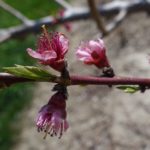Tree Fruit
Codling moths are flying in some parts of the state. Place your pheromone traps in the orchard during bloom. I have not yet caught any in my traps but expect to soon. We define biofix as the first sustained flight of moths. Therefore, we don’t determine biofix when that first moth shows up in the[Read More…]
The last few weeks has been a dark time for our industry. We have lost some of the stalwarts of the fruit and vegetable industries. We remember: George A. Adrian, 95, Indianapolis Thomas E. Roney, 70, Greenfield Gene M. Wild, 90, Zionsville John Hilger, Ft. Wayne Abner J. Horrall, 85, Bicknell While these folks came[Read More…]
One of the first and most important parts of a good insect and mite management program is the application of an early season oil spray to control European red mites, San Jose scale, and several species of aphids. Scales overwinter on the tree as nymphs and European red mites and aphids overwinter as eggs. Because[Read More…]
A number of growers have experienced increasing problems with woolly apple aphids over the last several seasons. Part of the reason for the increased populations may be related to the changing spectrum of insecticides you are using to control other pests. Our experience has been that many of the aphicides that are available that provide[Read More…]
One way insects communicate with individuals of the same species is with pheromones. Pheromones are volatile chemicals released by an insect that usually can be detected only by individuals of the same species. There are a number of different types of pheromones, but the most common type is the sex pheromone. Usually the females will[Read More…]
As the spray season approaches, it is good to remember the profound impact water quality has on the performance of pesticides used by fruit growers. Purdue Pesticides Program recently published a guide, The Impact of Water Quality on Pesticide Performance PPP-86, available at the Education Store, 1-888-EXT-INFO or www.extension.purdue.edu/store/. I highly recommend this guide to[Read More…]
The results of a historical primate behavior analysis suggest that species with fruit-filled diets evolved larger brains. A popular theory among evolutionary biologists is that we have our sociability to thank for our big brains. This “social brain hypothesis” suggests that the mental effort involved in interacting with others eventually increased our cognitive capacity. However,[Read More…]


